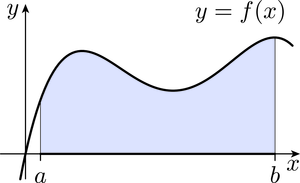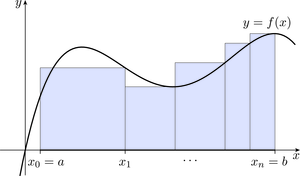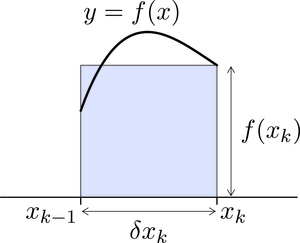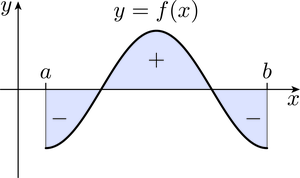1.2 Integration on the real line
We wish to define the Riemann integral of a continuous real function in such a way that if is positive on some interval , then the integral of from to is the area under the graph of between and . This is illustrated by the shaded part of Figure 8. To do this, we first split the interval into a collection of subintervals called a partition.
Definitions
A partition of the interval is a finite collection of subintervals of ,
for which
The length of the subinterval is .
We use to denote the maximum length of all the subintervals, so
Given a partition of , we can approximate the area under the graph of between and by constructing a sequence of rectangles, as shown in Figure 9.
Here the th rectangle has base and height (so the top-right corner of the rectangle touches the curve). The area of the rectangle is (see Figure 10). Note that we could equally have chosen the rectangle to be of height for any point in , and the theory would still work. This is because, for a continuous function , the difference between one set of choices of values for , , and another disappears when we take limits of partitions. We have chosen merely for convenience.
Summing the areas of all the rectangles gives an approximation to the area under the graph. This sum is called the Riemann sum for , with respect to this particular partition. (You may have seen upper Riemann sum and lower Riemann sum defined slightly differently elsewhere.)
Definition
The Riemann sum for with respect to the partition
is the sum
We now calculate the Riemann sum for a particular choice of function and partition, and then ask you to do the same for a second function.
Example 1
Let , where . Show that for
we have
and determine .
Solution
Each of the subintervals of has length . Therefore
Using the identity
we obtain
as required.
Finally, since is a basic null sequence, we see that
Now try the following exercise, making use of the identity
Exercise 1
Let , where . Show that for
we have
and determine .
Answer
Each of the subintervals of has length . Therefore
as required.
Since is a basic null sequence, we see that
The Riemann sums of Example 1 approximate the area under the graph of between and . The approximation improves as increases, and we expect the limiting value to actually be the area under the graph. However, to be sure that this limit gives us a sensible value, we should check that for any sequence of partitions of such that . The following important theorem, for which we omit the proof, provides this check.
Theorem 1
Let be a continuous function. Then there is a real number such that
for any sequence of partitions of such that .
We can now define the Riemann integral of a continuous function.
Definition
Let be a continuous function, where . The value determined by Theorem 1 is called the Riemann integral of over , and it is denoted by
The theorem tells us that to calculate the Riemann integral of over , we can make any choice of partitions for which and calculate . Thus the calculation of Example 1 really does demonstrate that
We define the Riemann integral when , as follows.
Definitions
Let be a continuous real function.
If , and is contained in the domain of , then we define
Also, for values of in the domain of , we define
As we have discussed, for a continuous real function that takes only positive values on , where , the Riemann integral
measures the area under the graph of between and . If we no longer require to be positive, then the integral still has a geometric meaning: it measures the signed area of the set between the curve , the -axis and the vertical lines and , where we count parts of the set above the -axis as having positive area, and parts of the set below the -axis as having negative area, as illustrated in Figure 11.




